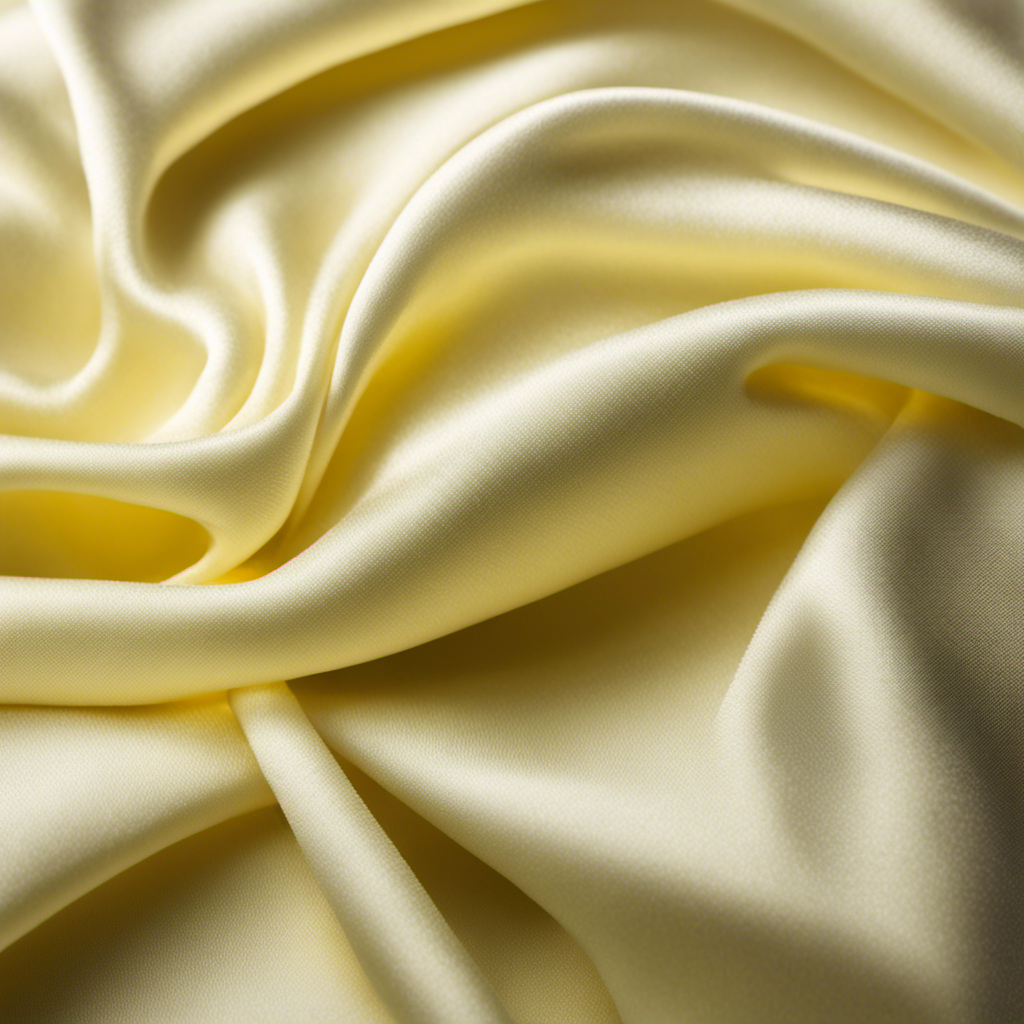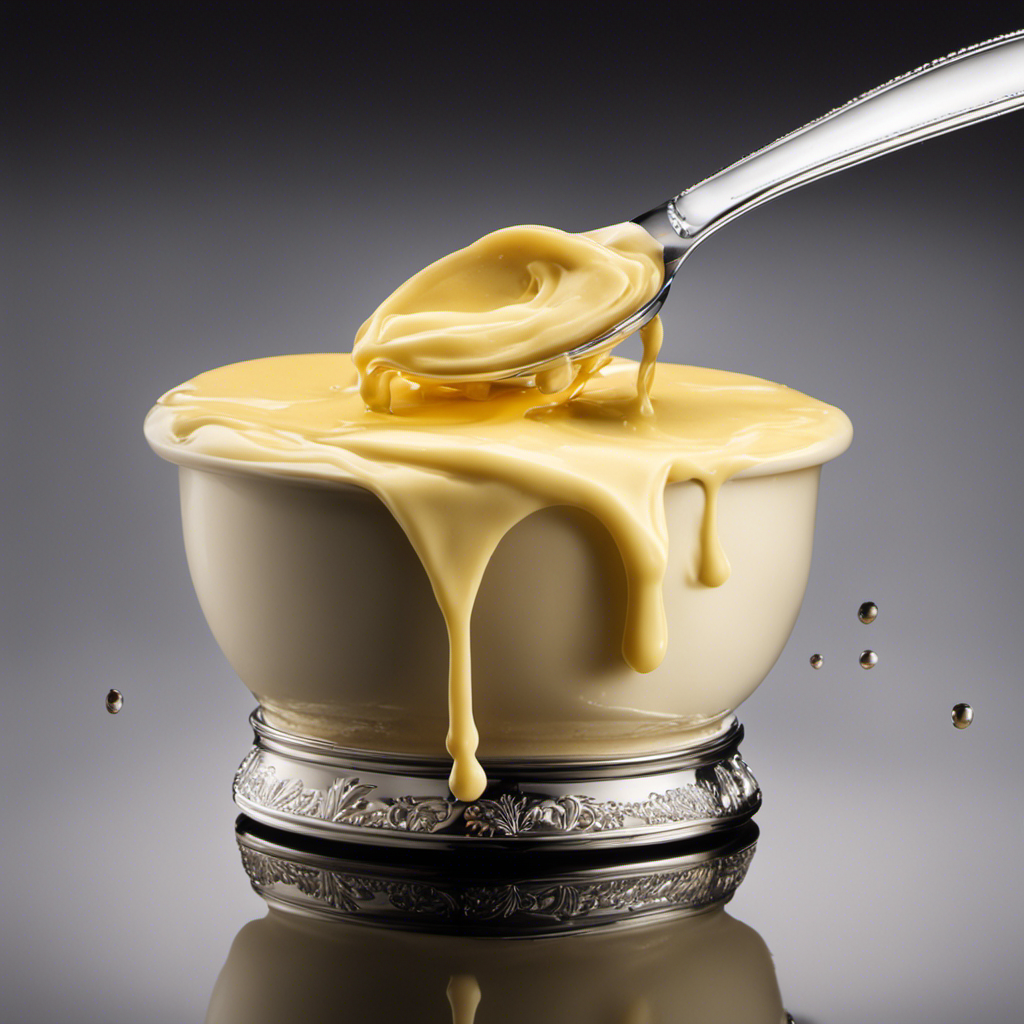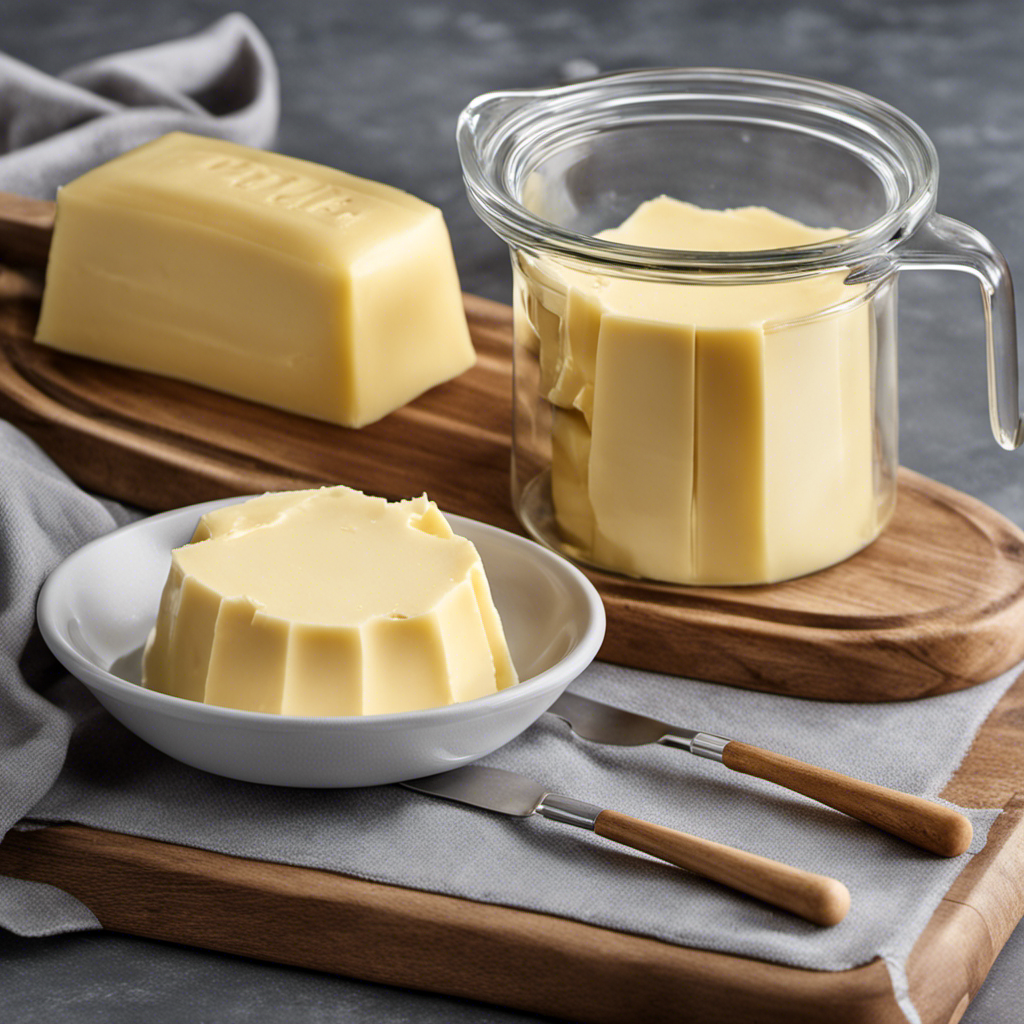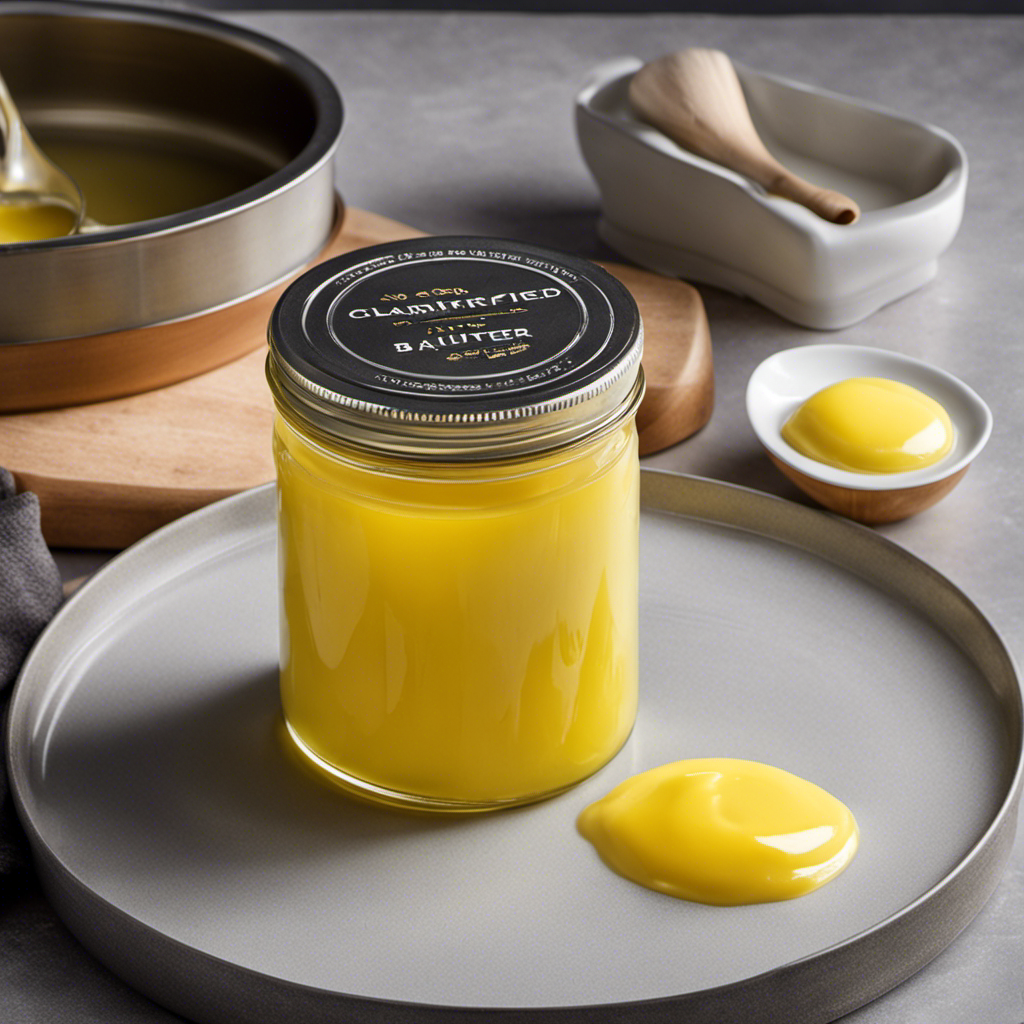I understand that feeling all too well – the frustration that comes from spotting a persistent butter stain on your beloved attire. However, there’s no need to worry, as I have some reliable solutions to remove those troublesome spots for you.
In this article, I’ll walk you through step-by-step instructions on how to tackle butter stains using everyday household items. From dish soap to vinegar, lemon juice to hot water, I’ll share practical tips and tricks to help you save your clothes and keep them looking fresh.
Key Takeaways
- Acting quickly is crucial to prevent the butter stain from setting.
- Avoid rubbing the stain to prevent spreading and embedding the butter deeper into the fabric.
- Pre-treating methods include using dish soap, vinegar, and baking soda to remove butter stains.
- Always check the care label and test the solution on a small area first before treating the entire stain.
Understanding Butter Stains
To understand butter stains, you need to know that they can be quite stubborn to remove from clothing. Butter stain removal techniques are essential to tackle these greasy marks effectively.
One of the most common causes of butter stains on clothes is accidental spills while eating or cooking. The greasy nature of butter makes it easily adhere to fabric fibers, resulting in unsightly stains.
When it comes to removing butter stains, it is crucial to act quickly. Blotting the stain with a paper towel or cloth can help absorb excess grease. Avoid rubbing the stain, as it can spread and embed the butter deeper into the fabric.
Now, let’s move on to the next section and explore pre-treating butter stains.
Pre-Treating Butter Stains
First, you’ll want to gently scrape off any excess butter from your clothing before treating the stain. This will prevent further spreading and absorption into the fabric. To effectively remove butter stains, there are several pre-treatment techniques you can try. Here are some practical methods:
| Technique | Steps |
|---|---|
| Dish Soap | 1. Apply a small amount of dish soap to the stain. |
| 2. Gently rub the fabric together to create suds. | |
| 3. Rinse with cold water and check if the stain is gone. If not, repeat the process. | |
| 4. Launder as usual. | |
| White Vinegar | 1. Mix equal parts of white vinegar and water. |
| 2. Dab the mixture onto the stain using a clean cloth or sponge. | |
| 3. Let it sit for 15 minutes. | |
| 4. Rinse with cold water and wash as usual. | |
| Baking Soda | 1. Make a paste using baking soda and water. |
| 2. Apply the paste to the stain and gently rub it in. | |
| 3. Let it sit for 30 minutes. | |
| 4. Rinse with cold water and launder as usual. |
These pre-treatment techniques can effectively remove butter stains from your clothes. Remember to always check the care label of your garment before attempting any stain removal method and test the solution on a small, inconspicuous area first to ensure it doesn’t cause any damage.
Using Dish Soap to Remove Butter Stains
When using dish soap to remove butter stains, make sure to apply a small amount of it directly onto the stain. Dish soap is effective in breaking down the grease and oil in butter stains. To enhance its stain-removing power, you can add a few drops of lemon juice or rub the stain with a sliced citrus fruit. The citric acid in the fruits helps to break down the butter and lift it from the fabric.
Additionally, temperature plays a crucial role in removing butter stains. Warm water can help to loosen the stain, making it easier to remove. However, avoid using hot water as it can set the stain further.
Now that we understand how to use dish soap, let’s explore another effective method for removing butter stains: applying vinegar.
Applying Vinegar to Butter Stains
In my experience, using vinegar to remove butter stains has been quite effective. Vinegar is known for its natural cleaning properties and can break down the grease in butter stains.
However, if vinegar is not readily available, there are alternative stain removal methods that can be used, such as using baking soda or lemon juice.
It is important to note that when using vinegar, precautions should be taken, such as diluting it with water and testing it on a small, inconspicuous area of the fabric first to ensure it does not cause any damage.
Effectiveness of Vinegar
You might want to try using vinegar to remove the butter stain from your clothes. Vinegar is an effective stain remover due to its acidic properties. When applied to a butter stain, vinegar works to break down the fats and oils, making it easier to lift the stain from the fabric.
It is important to act quickly and blot the stain with a clean cloth before applying vinegar. Simply mix equal parts vinegar and warm water, and gently dab the mixture onto the stain using a sponge or cloth. Let it sit for a few minutes, then rinse with cold water.
Vinegar can also be used to remove other stains, such as coffee or ink. Its versatility and affordability make it a must-have in any stain removal arsenal.
Alternative Stain Removal Methods
Now that we’ve explored the effectiveness of vinegar in removing butter stains, let’s discuss some alternative methods to tackle these stubborn marks. There are several butter stain removal hacks and natural remedies that can come to the rescue when you find yourself with a greasy spot on your favorite shirt. Here are a few tried and tested methods:
| Method | Instructions |
|---|---|
| Dish Soap | Apply a small amount of dish soap directly onto the stain, gently rub it in, and let it sit for 5-10 minutes. Rinse the garment with cold water and wash as usual. |
| Baking Soda | Make a paste using baking soda and water, apply it to the stain, and let it sit for 30 minutes. Rinse with cold water and wash as usual. |
| Lemon Juice | Squeeze fresh lemon juice onto the stain, rub it in, and let it sit for 10-15 minutes. Rinse with cold water and wash as usual. |
| Cornstarch | Cover the stain with cornstarch and let it sit for several hours or overnight. Brush off the cornstarch and wash the garment as usual. |
These natural remedies for butter stains can be quite effective, but always remember to test them on a small, inconspicuous area of the fabric before applying them to the entire stain.
Precautions When Using Vinegar?
When using vinegar as a stain remover, it’s important to be cautious and avoid applying it directly to delicate fabrics. Vinegar can be a powerful tool for removing stains, but it’s important to take proper precautions to avoid damaging your clothing. Here are some tips to keep in mind when using vinegar as a stain remover:
-
Dilute the vinegar: Before applying vinegar to a stain, make sure to dilute it with water. This will help to prevent any potential damage to the fabric.
-
Test for colorfastness: Before treating a stained garment with vinegar, it’s a good idea to test it on a small, inconspicuous area first. This will ensure that the vinegar won’t cause any discoloration or damage to the fabric.
-
Blot, don’t rub: When using vinegar to remove a stain, it’s important to blot the stain gently rather than rubbing it vigorously. Rubbing can push the stain deeper into the fabric and make it harder to remove.
-
Wash thoroughly: After treating a stain with vinegar, it’s important to wash the garment thoroughly to remove any vinegar residue. This will help to prevent any lingering vinegar smell.
Lemon Juice Remedy for Butter Stains
To remove a butter stain from clothes, try using a lemon juice remedy. Lemon juice is a natural stain remover that can effectively break down the oily residue left by butter.
If you don’t have lemon juice on hand, there are a few alternatives you can try. White vinegar is another great natural stain remover that can work just as well as lemon juice. Simply mix equal parts vinegar and water, then apply the solution to the stain and let it sit for a few minutes before washing the garment as usual.
Another option is to use baking soda. Make a paste by mixing baking soda with water and apply it to the stain. Allow it to sit for a few minutes before rinsing and washing the clothing.
These lemon juice alternatives are effective and safe to use on most fabrics, but it’s always a good idea to test them on a small, inconspicuous area of the clothing first.
Baking Soda Solution for Butter Stains
I’ve found that baking soda is a highly effective solution for removing stubborn stains, including butter stains, from clothing.
The key to successfully using baking soda for stain removal lies in the application technique. By following a few simple steps, you can maximize the effectiveness of baking soda and restore your clothes to their original condition.
Let me share with you some practical tips and techniques for applying baking soda to effectively remove stains.
Effective Stain Removal
You can effectively remove butter stains from your clothes by using a mixture of dish soap and warm water. Here’s how:
-
Act quickly: As soon as you notice the butter stain, try to remove as much excess butter as possible by gently scraping it off with a spoon or butter knife.
-
Blot the stain: Place a clean cloth or paper towel underneath the stained area and gently blot the stain with another cloth or paper towel. This will help absorb the butter and prevent it from spreading further.
-
Create a cleaning solution: Mix a small amount of dish soap with warm water to create a soapy solution. Make sure the water is not too hot, as it can set the stain.
-
Apply the solution: Dip a clean cloth or sponge into the soapy solution and gently dab it onto the stain. Avoid rubbing, as this can push the stain deeper into the fabric. Continue dabbing until the stain starts to lift.
Baking Soda Application Techniques?
Mixing baking soda with water to create a paste is an effective technique for removing stains from various surfaces. Baking soda, also known as sodium bicarbonate, has long been recognized for its cleaning properties. It is a gentle abrasive that helps to lift stains without damaging the surface.
When combined with water, it forms a paste that can be applied directly to the stain. Simply spread the paste onto the affected area, gently rub it in using a cloth or sponge, and let it sit for a few minutes. Then, rinse off the paste with water and pat dry.
The baking soda will help to break down the stain and lift it from the surface. As an alternative to baking soda, you can also try using vinegar or lemon juice, which have similar stain-removing properties. However, it’s important to note that these alternatives may not be as effective as baking soda.
Using Stain Remover on Butter Stains
To remove a butter stain from your clothes, apply a stain remover directly onto the affected area. This will help break down the oils in the butter and loosen the stain.
Here are four practical tips to help you effectively remove butter stains:
-
Act quickly: The sooner you treat the stain, the better chance you have of removing it completely.
-
Blot the stain: Use a clean cloth or paper towel to gently blot the stain, absorbing as much butter as possible.
-
Apply the stain remover: Follow the instructions on the stain remover bottle and apply it directly onto the stain. Make sure to saturate the affected area.
-
Launder as usual: Wash the garment according to the care instructions. Check if the stain is completely gone before drying. If not, repeat the process or try using a different stain remover.
Hot Water and Detergent Method for Butter Stains
If you want to remove butter stains from your clothes, one effective method is using hot water and detergent. This method is practical and easy to do at home.
First, start by blotting the stained area with a clean cloth or paper towel to remove any excess butter. Then, run the stained garment under hot water to loosen the stain.
Next, apply a small amount of liquid detergent directly onto the stain and gently rub it in using your fingers or a soft brush. Let it sit for a few minutes to allow the detergent to penetrate the stain.
After that, wash the garment in hot water using your regular laundry detergent. Finally, check if the stain is completely gone before drying the clothes.
This method works well for fresh butter stains, but for tougher stains, you may need to try other methods like using vinegar and dish soap.
Removing Butter Stains From Different Fabrics
Removing butter stains from various fabrics can be challenging, but with the right method, it’s possible to effectively treat them. Here are some tips to help you remove butter stains from different fabrics:
-
Blot the stain: Use a clean cloth or paper towel to blot the excess butter from the fabric. Avoid rubbing the stain as it can spread and make the situation worse.
-
Pre-treat with dish soap: Apply a small amount of dish soap directly to the stain. Gently rub it into the fabric using your fingers or a soft brush. Let it sit for about 10 minutes to allow the soap to penetrate the stain.
-
Rinse with cold water: Rinse the stained area with cold water to remove the dish soap and butter residue. Make sure the water runs through the fabric from the backside to help push the stain out.
-
Launder as usual: Wash the garment as you normally would, following the care instructions on the fabric label. Check the stained area before drying, and if the stain is still visible, repeat the process.
When dealing with delicate fabrics like silk, it’s important to be extra careful. Avoid using hot water and harsh chemicals as they can damage the fabric. Instead, try using a mild detergent specifically designed for silk and follow the same steps mentioned above.
Prevention is also key, so be cautious when eating buttery foods and consider using a napkin or bib to protect your clothes.
Tips for Treating Set-In Butter Stains
Treating set-in butter stains can be challenging, but with the right method, it’s still possible to effectively treat them.
When it comes to butter stain removal techniques, one effective method is using baking soda for set-in stains. Baking soda is a versatile household ingredient that can help break down the grease in the butter stain and lift it from the fabric.
To use baking soda, mix it with enough water to form a paste and apply it to the stained area. Gently rub the paste into the fabric using a soft brush or your fingers. Let it sit for about 30 minutes, then rinse with cold water and launder as usual.
This method can work wonders in removing stubborn butter stains from clothes.
Now that we know how to treat set-in butter stains, let’s explore some tips for preventing these stains on clothes.
Preventing Butter Stains on Clothes
To prevent butter stains on your clothes, it’s important to be mindful of how you handle and consume butter. Here are some practical tips to help you avoid grease stains:
-
Be cautious when spreading butter: When spreading butter on bread or toast, use a knife or spatula instead of your fingers to minimize the chances of getting butter on your clothes.
-
Use butter dishes or covers: Keep your butter in a covered dish or container to prevent any accidental spills or splatters.
-
Wait for the butter to soften: If you’re planning to melt butter, allow it to soften at room temperature instead of using a microwave. This way, you can control the melting process and reduce the risk of splattering.
-
Protect your clothes: When cooking with butter, wear an apron or protective clothing to shield your clothes from any potential stains.
Frequently Asked Questions
Can I Use Regular Soap Instead of Dish Soap to Remove Butter Stains?
I wouldn’t recommend using regular soap instead of dish soap for butter stains. Dish soap is specifically designed to cut through grease and oil, making it more effective in removing butter stains.
How Long Should I Let the Vinegar Sit on the Butter Stain Before Washing?
I usually let the vinegar sit on the butter stain for about 15-30 minutes before washing. Vinegar is effective in removing butter stains. It’s important to give it enough time to penetrate and break down the stain.
Will Lemon Juice Bleach or Discolor the Fabric When Used as a Remedy for Butter Stains?
Using lemon juice as a remedy for butter stains won’t bleach or discolor the fabric. However, it’s necessary to wash the fabric immediately after treating the stain. As for vinegar, it won’t damage the fabric either.
Can I Use Baking Powder Instead of Baking Soda to Create the Solution for Butter Stains?
I can use baking powder as a substitute for baking soda when creating a solution for butter stains. Additionally, I can try using an alternative to dish soap to effectively remove the stain from my clothes.
Is It Safe to Use Hot Water and Detergent on Delicate Fabrics to Remove Butter Stains?
Using hot water and detergent on delicate fabrics to remove butter stains is not recommended. Cold water is safer and less likely to damage the fabric. Alternative methods include using dish soap or rubbing alcohol.
Conclusion
So there you have it, my fellow butter stain warriors! We’ve come to the end of our butter stain removal journey, armed with knowledge and practical tips to tackle this greasy nemesis.
By pre-treating, using dish soap, vinegar, lemon juice, or hot water and detergent, we can banish butter stains from our clothes for good.
Remember, different fabrics require different approaches, and don’t forget to tackle set-in stains with extra care.
With these techniques in your arsenal, you’ll be able to prevent and conquer butter stains with ease.
Stay clean and butter-free, my friends!









